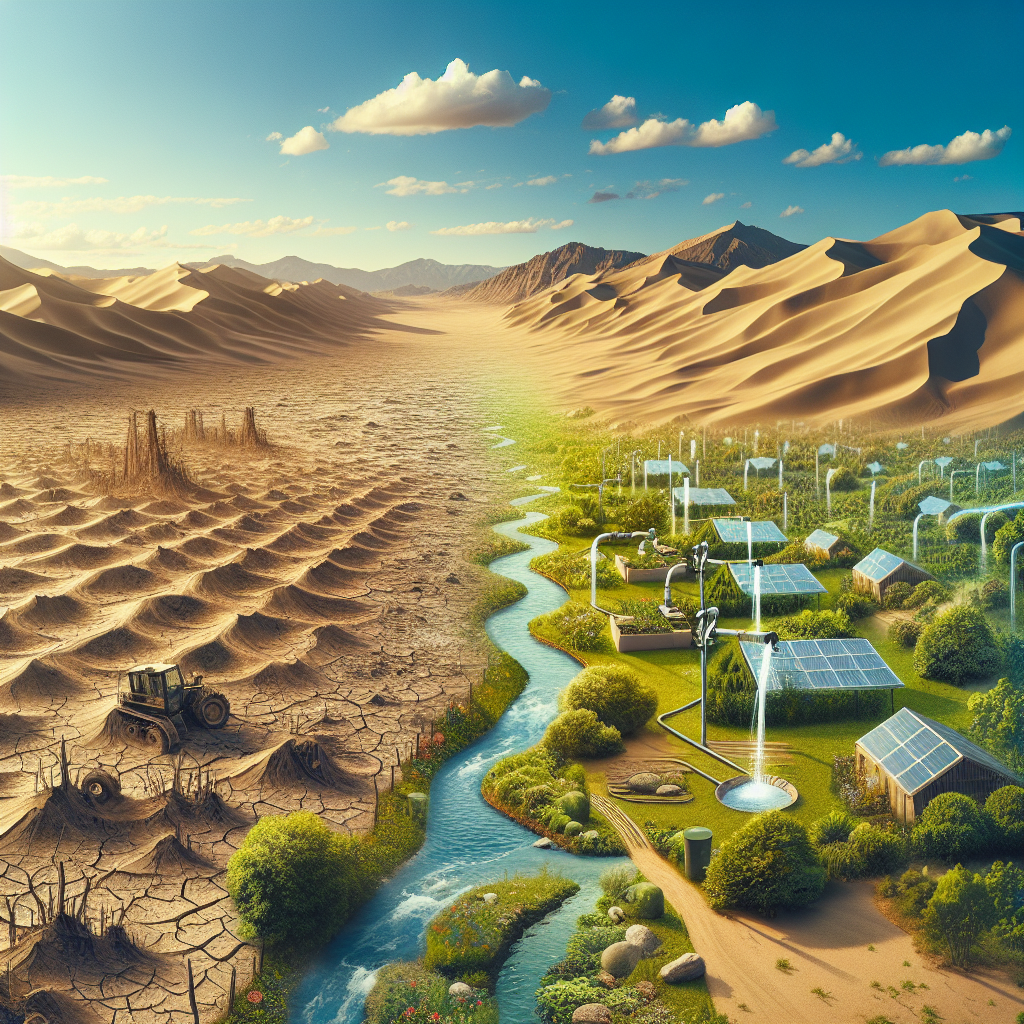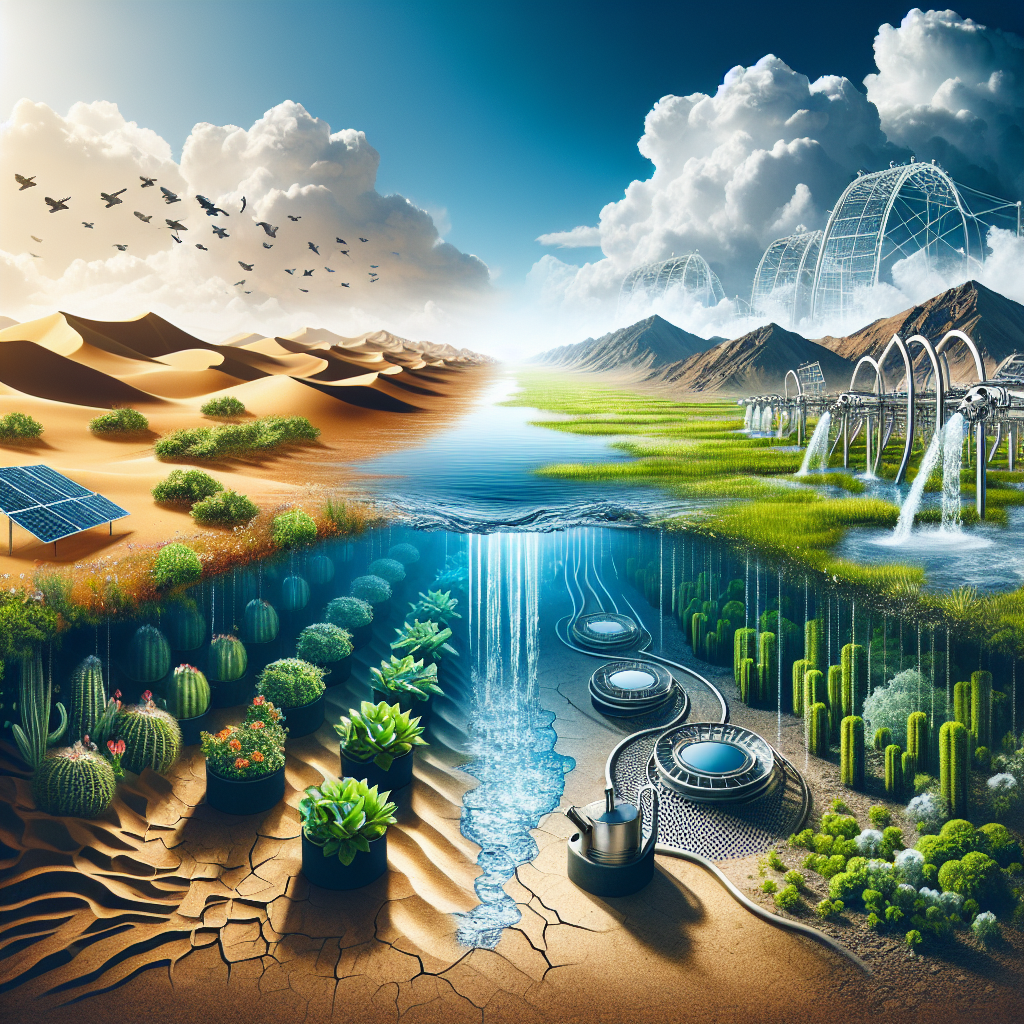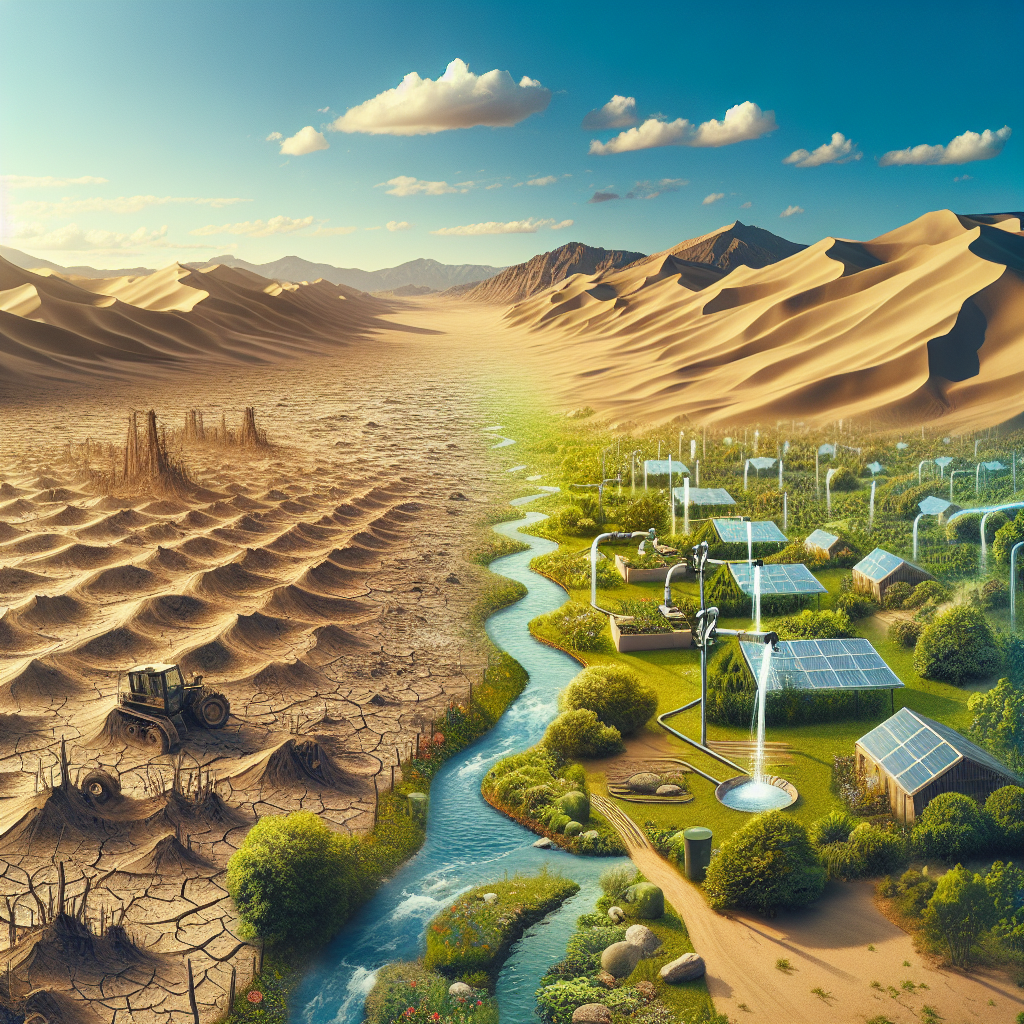In this article, you will discover some effective techniques to conserve water in dry climates. With the increasing scarcity of water in many regions, it is crucial to find innovative ways to preserve this valuable resource. From implementing efficient irrigation systems to utilizing drought-tolerant plants, these techniques will not only help you reduce your water consumption but also contribute to the overall conservation efforts in dry climates. So, let’s explore these practical methods that will assist you in maintaining a sustainable water supply, even in the most arid environments!

Understanding Water Scarcity in Dry Climates
Causes of water scarcity in dry climates
Water scarcity in dry climates is primarily caused by the limited availability of water resources. In regions with low rainfall and high evaporation rates, such as arid and semi-arid areas, the natural water supply is already limited. Additionally, factors like population growth, urbanization, and agricultural practices further stress water resources. Increased demand for water without corresponding supply leads to water scarcity.
Impact of water scarcity on the environment and communities
Water scarcity has far-reaching impacts on the environment and communities in dry climates. The lack of water affects ecosystems, leading to a decline in biodiversity and the degradation of habitats. It also disrupts the balance of key ecological processes, such as nutrient cycling and water purification. For communities, water scarcity can cause serious socio-economic challenges, including reduced agricultural productivity, compromised access to clean drinking water, and increased conflicts over limited water resources.
The need for water conservation in dry climates
Given the challenges posed by water scarcity in dry climates, water conservation becomes crucial. By adopting efficient water management practices, communities and individuals can help alleviate the strain on water resources. Water conservation not only ensures the availability of water for essential needs but also protects the environment and supports sustainable development in dry regions.
Assessing Water Usage and Identifying Inefficiencies
Measuring water consumption
Before implementing water conservation measures, it is important to assess how much water is being used. Measuring water consumption can be done by installing water meters or using monthly utility bills to track water usage. By understanding the baseline consumption, it becomes easier to identify areas where water can be conserved.
Identifying sources of water waste
Once water consumption is measured, it is necessary to identify the sources of water waste. Common sources of water waste in dry climates may include inefficient irrigation systems, leaking pipes, and improper water practices indoors. By identifying these sources, appropriate steps can be taken to mitigate water waste and improve efficiency.
Evaluating inefficient water use practices
Evaluating inefficient water use practices involves identifying behaviors or habits that contribute to unnecessary water consumption. In dry climates, common inefficient practices may include leaving faucets running, excessive use of water for cleaning or landscaping, and using outdated appliances that are not water-efficient. By recognizing these practices, individuals can make conscious efforts to change their behaviors and reduce water usage.
Implementing Water-Efficient Landscaping
Choosing drought-tolerant plants
One effective way to conserve water in dry climates is to choose drought-tolerant plants for landscaping. These plants are adapted to survive with minimal water and require less irrigation. Native plants and those with low water requirements, such as succulents and cacti, are suitable choices for dry climate landscaping.
Xeriscaping principles and techniques
Xeriscaping is a landscaping technique that emphasizes water conservation in dry climates. By following xeriscaping principles, such as grouping plants with similar water needs, using efficient irrigation methods, and incorporating hardscapes, water usage can be significantly reduced. Xeriscaping also promotes sustainable practices by considering soil conditions, climate, and optimizing water use.
Using mulch and ground covers to reduce evaporation
Mulching the soil and using ground covers around plants can help retain moisture, reduce evaporation, and minimize weed growth. In dry climates, applying a thick layer of organic mulch, such as wood chips or compost, around plants can prevent water from evaporating quickly and keep the soil moist for a longer duration. This helps conserve water and supports plant growth.
Designing water-wise gardens
Designing water-wise gardens involves incorporating various elements that optimize water usage. This may include grouping plants according to their water needs, installing efficient irrigation systems, incorporating rainwater harvesting features, and creating microclimates to protect plants from harsh climatic conditions. By designing gardens that prioritize water efficiency, individuals can conserve water while maintaining visually appealing landscapes.
Optimizing Irrigation Systems
Selecting appropriate irrigation methods
Choosing the right irrigation method is crucial for water conservation in dry climates. Drip irrigation, soaker hoses, and micro-sprinklers are examples of efficient irrigation methods that deliver water directly to plant roots, minimizing water loss through evaporation or runoff. Assessing the water needs of specific plants and using the appropriate irrigation method can greatly reduce water wastage.
Installing drip irrigation systems
Drip irrigation systems provide targeted water delivery to plants, minimizing water loss through evaporation. By installing drip irrigation systems, water is directly applied to the root zone of plants, reducing water waste and ensuring efficient water usage. Drip systems can be automated and regulated to provide plants with the required amount of water without overwatering.
Utilizing smart irrigation controllers and sensors
Smart irrigation controllers, also known as weather-based controllers, use real-time weather data to adjust the irrigation schedule based on current conditions. Sensors can detect moisture levels in the soil, further minimizing unnecessary watering. By utilizing these technologies, water usage can be optimized, preventing overwatering and conserving water in dry climates.
Implementing rainwater harvesting for irrigation
Rainwater harvesting offers an effective solution for irrigation in dry climates. Collecting rainwater from rooftops or other surfaces and storing it in tanks or barrels can provide a supplementary water source for landscape irrigation. This reduces reliance on municipal water supplies and ensures that water is used efficiently.

Adopting Water-Saving Practices Indoors
Upgrading to low-flow fixtures and appliances
One of the easiest ways to conserve water indoors is by upgrading to low-flow fixtures and appliances. Low-flow toilets, faucets, and showerheads are designed to use significantly less water without compromising performance. By replacing older, water-intensive fixtures, households can save a significant amount of water in their daily routines.
Using water-efficient showerheads and faucets
Water-efficient showerheads and faucets incorporate aerators, pressure regulators, and flow restrictors to reduce water usage. These additions maintain water pressure while reducing the volume of water flowing, saving water without sacrificing functionality. Installing such fixtures ensures water conservation during showers, handwashing, and other household activities.
Implementing dual-flush toilets
Dual-flush toilets provide two flushing options, allowing users to choose a smaller flush for liquid waste and a larger flush for solid waste. With this system, unnecessary water is not wasted on smaller flushes. Implementing dual-flush toilets can lead to significant water savings, reducing the overall water footprint of households in dry climates.
Practicing water-conscious behaviors in the kitchen and bathroom
Simple yet effective practices in the kitchen and bathroom can contribute to water conservation. These practices include turning off the tap while brushing teeth or washing dishes, using dishwashers and washing machines when they are fully loaded, and fixing leaking faucets promptly. By adopting these water-conscious behaviors, individuals can make a big difference in reducing water usage indoors.
Managing Greywater for Non-Potable Uses
Understanding greywater and its potential uses
Greywater refers to wastewater generated from activities like laundry, dishwashing, and bathing. While not suitable for drinking, greywater can be safely used for non-potable purposes such as landscape irrigation or toilet flushing. Understanding the potential uses of greywater can help conserve water and reduce the strain on freshwater resources in dry climates.
Implementing greywater recycling systems
Greywater recycling systems collect, treat, and reuse wastewater for specific purposes. These systems filter and disinfect greywater, making it suitable for irrigation or flushing toilets. By implementing greywater recycling systems, households can significantly reduce their reliance on freshwater sources for non-potable uses, contributing to water conservation efforts.
Using greywater for landscape irrigation and toilet flushing
Greywater, when properly treated, can be used for landscape irrigation and toilet flushing. By directing greywater to gardens or using it to flush toilets, households can reduce their demand for freshwater resources. This not only conserves water but also helps in the sustainable management of water in dry climates.
Reducing Water Losses through Leakage Detection and Repair
The importance of addressing water leaks
Water leaks can result in substantial water losses and contribute to water scarcity in dry climates. Addressing leaks promptly is essential to prevent unnecessary wastage. Water leaks not only waste a valuable resource but also contribute to higher utility bills. By addressing leaks, individuals can save water and reduce their overall water consumption.
Performing regular leak detection and inspection
Regular leak detection and inspection play a crucial role in water conservation efforts. Routine checks for leaking pipes, faucets, and toilets can help identify and repair leaks promptly. Employing professionals or conducting DIY inspections can help capture and resolve leaks, further minimizing water losses in dry climates.
Repairing leaks promptly to minimize water losses
When leaks are detected, it is important to repair them promptly to minimize water losses. Repairing leaking pipes, faucets, or toilets can be as simple as replacing worn-out washers or o-rings. By promptly addressing leaks, individuals contribute to water conservation by preventing unnecessary water wastage.
Promoting Water Conservation through Education and Awareness
Educating communities about water conservation
Education plays a vital role in promoting water conservation in dry climates. Raising awareness about the importance of water conservation, the impact of water scarcity, and the techniques for water-efficient practices helps communities understand their role in conserving water. Educational initiatives can be carried out through workshops, seminars, school programs, and community outreach.
Encouraging behavioral changes and responsible water use
Encouraging behavioral changes is crucial in fostering responsible water use in communities. By promoting simple actions like turning off taps, fixing leaks, and using water-efficient appliances, individuals can contribute to water conservation efforts. Community engagement through campaigns, social media, and local organizations helps reinforce the message of responsible water use and encourages positive behavioral changes.
Raising awareness through campaigns and initiatives
Water conservation campaigns and initiatives can be powerful tools in raising awareness and promoting sustainable water practices. These efforts can involve public service announcements, media collaborations, community events, and social media campaigns. By engaging individuals and communities, these initiatives can amplify the message of water conservation and inspire collective action.
Exploring Government Policies and Incentives
Supportive policies for water conservation
Government policies play a significant role in promoting water conservation in dry climates. Policies can include regulations on water usage, restrictions on wasteful practices, and incentives for implementing water-efficient technologies. Supportive policies create an enabling environment for individuals, businesses, and communities to adopt and prioritize water conservation measures.
Financial incentives for implementing water-saving techniques
Financial incentives can greatly encourage individuals and businesses to adopt water-saving techniques. Rebates, tax credits, and grants can offset the costs associated with installing water-efficient fixtures, appliances, or irrigation systems. By providing financial benefits, governments incentivize water conservation and motivate people to make sustainable choices in water management.
Tax rebates and grants for water-efficient upgrades
Tax rebates and grants further support the adoption of water-efficient upgrades. These incentives can be provided to homeowners, businesses, or agricultural activities that invest in water-saving technologies. By reducing the financial burden of implementing water-efficient upgrades, these incentives drive wider adoption of sustainable practices in water management.
Engaging in Community Efforts for Water Sustainability
Participating in local water conservation programs
Local water conservation programs provide opportunities for individuals to actively engage in water sustainability efforts. This may include participating in community cleanup activities, volunteering for water monitoring programs, or assisting in educational campaigns. By actively participating, individuals contribute to the collective goal of water conservation in their local communities.
Collaborating with neighbors for collective water-saving efforts
Engaging with neighbors and fostering a sense of community can lead to collective water-saving efforts. By discussing water conservation techniques, sharing resources, and inspiring each other, neighbors can collectively reduce water usage and create a more sustainable community. Collaboration can also promote a sense of social responsibility towards water conservation.
Joining community initiatives and water-saving campaigns
Joining existing community initiatives and water-saving campaigns amplifies individual efforts and provides an avenue for collective action. Whether it be joining local conservation groups, participating in water-saving competitions, or supporting community-led projects, individuals can contribute to larger-scale water sustainability efforts. Together, these initiatives can create a significant impact in conserving water in dry climates.
In conclusion, addressing water scarcity in dry climates requires a combination of understanding the causes, implementing efficient practices, and promoting conservation efforts at all levels. By adopting water-efficient landscaping, optimizing irrigation systems, implementing water-saving practices indoors, managing greywater, addressing leaks, promoting education and awareness, exploring government policies, and engaging in community efforts, individuals and communities can make a substantial difference in ensuring water sustainability in dry climates.

